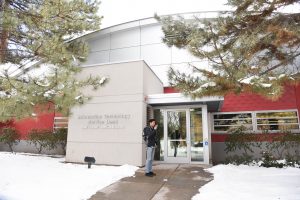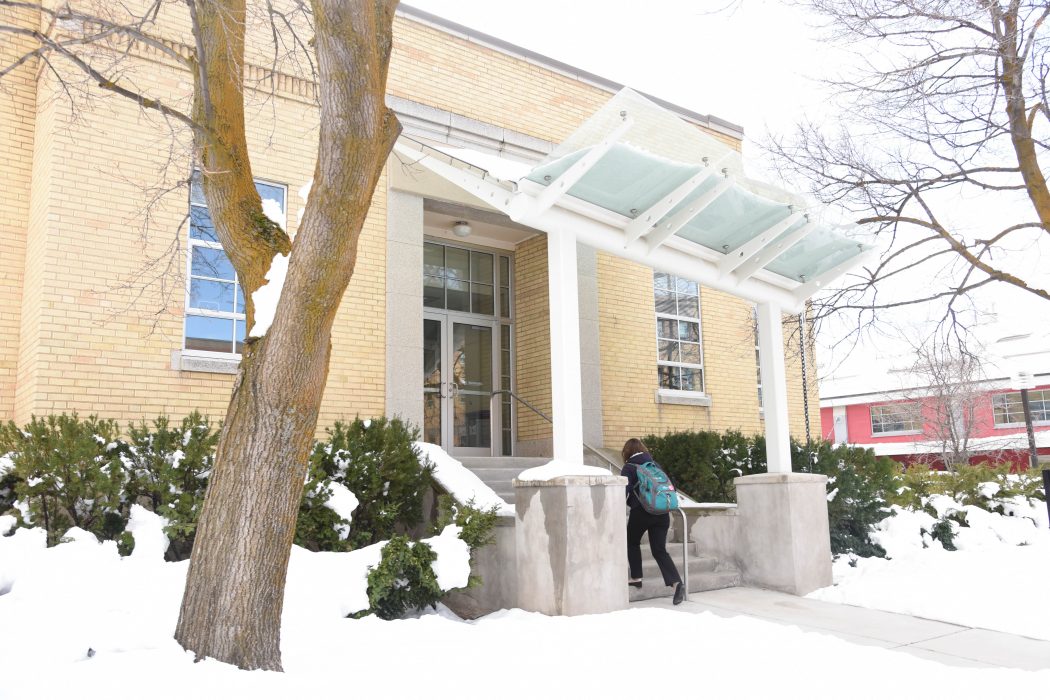Buildings of USU: JQL and Lillywhite
Take a walk around campus and some might notice a theme in the architectural aspects of this university as well as note the serenity from the surrounding history and architecture.
One such architectural structure is the Lillywhite building, tucked away on Aggie Boulevard on Utah State University’s main campus.
Named after Ray L. and Eloise H. Lillywhite, this building with its familiar white brick structure and intricate design is home to the Communicative Disorders and Deaf Education Department(COMDDE) — which include majors such as audiology, speech-language pathology and deaf education.
Constructed in 1946, this building was originally a workshop and warehouse building, complete with a carpenter’s shop, a vehicle maintenance shop, the campus motor pool and the police department headquarters.
Jeffery Larsen, a clinical associate professor in the COMDDE department said, “it’s been here forever. We have since renovated and remodeled, spreading out a little between the Lillywhite building and the Ellen Eccles Jones College of Education and Human Services building.”
In addition to providing educational experiences to students through classes offered here on campus, the Lillywhite Building also houses two clinics — the Speech-Pathology Clinic and the Audiology Clinic.
“These clinics serve not only students, but also children and adults in the community. We do hearing tests, balance tests, sell hearing aids and also service them here on campus,” Larsen said.
Megan Carver, a first year student in the communicative disorders and deaf education program, said she has loved all of the classes she has taken for her major. One of her favorites has been the anatomy of speech mechanisms.
“We studied the respiratory system, vocal folds, the voice box, larynx, the nervous system and the way neurons work,” Carver said. “I really liked that because talking is so natural for us, but there is a lot more going on that we don’t pay attention to while we are speaking.”
Larsen said almost all the classes within the COMDDE program are held in the Lillywhite building.
“The building is unique in and of itself,” said Kayla Hawkes, a speech-language pathology major,, “and the professors in the COMDDE program are amazing.”
In addition to all the great classes and opportunities for students within the COMDDE program, there are also experiences for students outside of the classroom.
The Student Academy of Audiology works in partnership with the Starkey Hearing Foundation to host projects and events.
As a humanitarian project, students raise funds in order to go on different trips to other countries. The money they raise helps them travel or helps them pay for the hearing aids they will administer to the people needing help within the countries they visit.
This project has been a huge hit for many students over the past 14 years. In past years, students have gone to Kenya, Ghana, Dominican Republic, Costa Rica, El Salvador, Mexico and Moab. This May, the Student Academy is going to Cambodia the week after graduation.
“There are several countries that don’t have access to the services that USU students are able to provide them, which is why these humanitarian efforts are so important to us and to the people we are helping,” Larsen said.
Along with the fundraisers the Student Academy has put together, there is also a vending area to help raise additional funding for the humanitarian efforts. Larsen encourages students to come check it out if they are looking for cheap snacks throughout the day.
Talk to any COMDDE student and they will tell you just how much they love the program, the professors and the atmosphere of the Lillywhite building.
“All of the professors are just top-notch,” Carver said. “They are all professionals within their fields and are wonderful at what they do.”
Hawkes agreed.
“Not to mention we have the best advisor and support system for what we are trying to do,” he said.
The Lillywhite building adds to the history of this uniquely historic campus in many ways.
“Although the Lillywhite building is pretty old, it offers services to those who need them,” Carver said. “We are helping others who can’t help themselves. It’s a great building with great people and great services provided to those in need.”
Another uniquely historic building on campus is the Janet Quinney Lawson (JQL) building which neighbors the Lillywhite building.
 The JQL building is one of the oldest buildings on campus, but has undergone many changes. It did not always house the Information Technology department it does today.
The JQL building is one of the oldest buildings on campus, but has undergone many changes. It did not always house the Information Technology department it does today.
Most people see this building as a red quonset hut — a semi-cylindrical metal shelter with end walls — buried behind trees and shrubs. Upon entering the inside, the building takes on a more industrial yet homey look with desktops and offices. It’s spacey, and innovative. Unseen by many people is the globe stenciled on the back window.
Janet Quinney Lawson herself helped in the renovation process. During her lifetime, she undertook multiple projects which include the Janet Quinney Lawson Theater and the JQL Building.
Fee Busby arrived long after the JQL’s inception, but remembers the rededication of the building. He said the building was used as an airport hangar during WWII and was an old quonset hut.
“It was basically a great big barn,” Busby said. “The first floor is mostly laboratories, which are locked down because of the expensive equipment there.”
While not many people know what the original purpose of the building was, it has served several different purposes throughout the history of USU.
Busby has no idea what the building was originally used for, but did confirm it was once a photo lab and was at one time a firehouse. It cost around 3 million dollars to renovate the building and make it usable. Before then, it had a few problems.
“In the front of the building, there used to be an emergency response van,” Busby said. “And right in front of the van was a trench. I was glad we never had to use it, because it never would have gotten out.”
Steve Funk, the overseer of the service desk for IT and development team, said the building has only been an IT building since 2004.
“Years ago, it came to be where they repaired tractors,” she said. “Probably about 20 years ago, in the section we are currently in, is where they used to do photo development.”
Three-fourths of the building belong to the College of Natural Resources department. There are several offices on the south of the building and there is a small section where the Center for People with Disabilities repair items like wheelchairs.
Logan Bringhurst is a volunteer in the assistive technology lab in the basement. He has only been there for three months.
“Clay Christensen is charge of the lab,” Bringhurst said. “ We might go a couple days without using the lab, and then get a whole bunch wanting to use it. One of the nice things about (this building) is that people that depend on their wheelchairs can get help quickly here.”
The lab helps out with other things for people as well, such as buying batteries for electric chairs.
“This particular chair I’m in has two batteries in it and to get those batteries downtown somewhere would be about $200 a piece,” he said. “Though if they order them up here, the batteries can be bought at about $75 a piece.”
Other things can be found at the lab such as small cardboard chairs for young people with disabilities.
Lane Koyle, a grad assistant completing his practicum hours through the school, helps students with disabilities in a program called Aggie Elevated, which helps students with intellectual disabilities further their education after high school.
Each section of the building functions independently of the other and simply know about the other’s existences.
“I have been at the university for about 23 years,” Funk said. “I’m not from here originally, I went to school here, graduated and they offered me a job. About 15 years ago, they remodeled this building and gave it more of the open industrial-type look.”
Students generally come to have their equipment looked at, but can appreciate the architecture of the building. When being informed of its previous purposes before being an IT building, they’re shocked.
Allison Hill, a major in landscape architecture, is one who appreciated the structure but was surprised to hear of its other purposes.
“I love the setting of the IT building,” Hill said. “I love repurposing stuff like that, I think it’s really cool.”
—kortni.marie.wells@aggiemail.usu.edu
@kortniwells
—fallrush92@gmail.com
@jcrummitt

